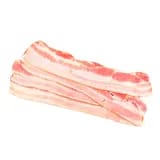Cod with bacon and mashed butternut squash
583 reviewsThis fish pleases everyone...the secret is in the bacon!

Ingredients
Make sure you have...
Utensils
Stovetop, Pot (small), Frying pan, Colander
recipe

Step 1
Wash and peel the butternut squash. Cut it in half lengthwise and remove the seeds. Cut into cubes.
Step 2
Add the cubed squash to a pot of salted boiling water. Lower heat to medium and cook for 20 minutes.


Step 3
In the meantime, season the cod filets with salt & pepper. Wrap each piece with 2 slices of bacon.
Step 4
Melt a dab of butter in a pan on medium-high heat. Add the bacon-wrapped cod and brown on all sides. Cover and cook for 6-8 minutes on medium heat.

Step 5
Drain the squash and add to a bowl. Add a dab of butter, salt, pepper, and mix until creamy.

Step 6
Serve the mashed squash with the cod. Season with salt & pepper and enjoy! Optional: Serve with a few arugula leaves.
Personal notes
Add your own flavor!
Nutrition facts
Average estimated amount for one serving
| Energy | 215 cal. |
| Fat | 8 g |
| Carbohydrates | 8 g |
| Protein | 26 g |
| Fiber | 3 g |
Values are based on an average estimate for one serving. All nutrition information presented on Jow is intended for informational purposes only. If you have any concerns or questions about your health, please consult with a health-care professional.
On average, one serving of the recipe "Cod with bacon and mashed butternut squash" contains 215 Energy, 8 g of Fat, 8 g of Carbohydrates, 26 g of Protein, 3 g of Fiber.
Price per portion
| € | Nos recettes à -2 € par portion |
| €€ | Nos recettes entre 2 € et 4 € par portion |
| €€€ | Nos recettes à +4 € par portion |
Please note, the price above is dependent on your grocer and the available products in the grocery store you chose.
Scores


A Nutri-score
The Nutri-score is an indicator intended for understanding nutritional information. Recipes or products are classified from A to E according to their food composition to promote (fiber, proteins, fruits, vegetables, legumes, etc.) and foods to limit (energy, saturated fatty acids, sugars, salt, etc.).
C Green-score
The Green-score is an indicator representing the environmental impact of food products. The recipes or products are classified from A+ to F. It takes into account several factors on the pollution of air, water, oceans, soil, as well as the impacts on the biosphere. These impacts are studied throughout the product life cycle.
Retrieving reviews...


